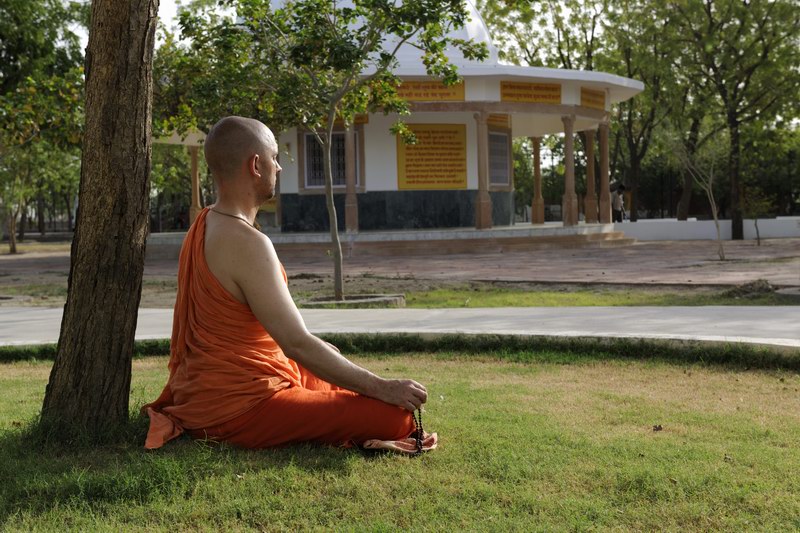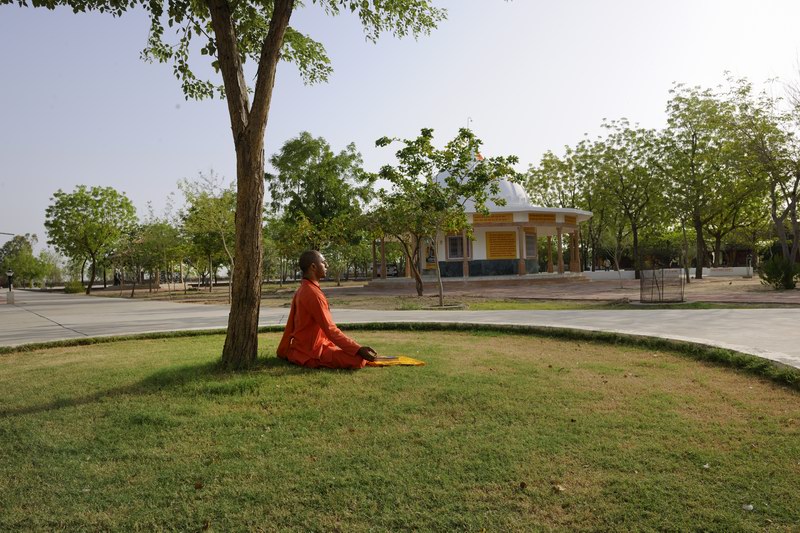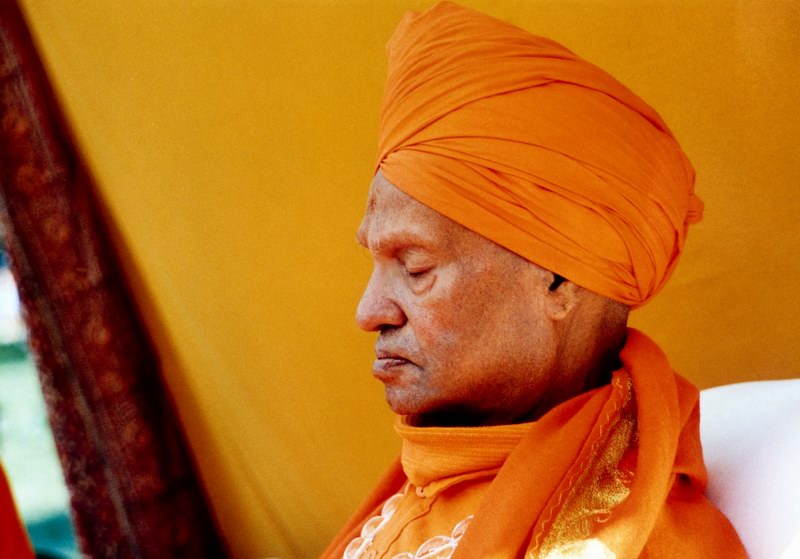Raja Yoga
Raja means King. A king acts with independence, self-confidence, and assurance. Likewise, a Raja Yogi is autonomous, independent and fearless. Raja Yoga is the path of self-discipline and practice.
Raja Yoga is also known as Ashtanga Yoga (Eight Steps of Yoga) because it is organised in eight parts:
- Yama - Self-control
- Niyama- Discipline
- Asana - Physical exercises
- Pranayama - Breath exercises
- Pratyahara - Withdrawal of the senses from external objects
- Dharana - Concentration
- Dhyana - Meditation
- Samadhi - Complete Realisation
The eight steps of Raja Yoga provide systematic instruction to attain inner peace, clarity, self-control, and Realisation.
Yama - Self-Control
consists of five principles:
- Ahimsa - Non-Violence
Ahimsa means not to cause pain or harm to any living being by thought, word or deed. Non-violence also means not to kill. Consumption of meat requires the death of an animal. It is due to this principle that Yogis are Vegetarian. Animals have a keen instinct, which heightens their awareness of impending death. They sense when they are to be slaughtered and are in mortal fear. Fear and stress hormones are released throughout their body. These hormones remain in the flesh of the slaughtered animal and are eaten by unsuspecting people. Many apparently groundless fears, neuroses, and psychoses have their origin in this food. - Satya - Truthfulness
To always speak the truth is good and correct, but more important is how we convey the truth. We have the capacity to hurl truth at someone like a knife, but we are also capable of clothing that same truth in loving words. In order not to violate the principle of Ahimsa as mentioned above, we should heed the advice of Mahaprabhuji, who said: “Each of your words should fall like flowers from your lips”. To be truthful also means not to hide your feelings, not to be evasive or make excuses. Perhaps for some time we can hide our true face from the eyes of others, but there is at least one person knows our inner truth - our own self. Our own consciousness is a witness. - Asteya - Non-Stealing
Asteya means that you should never take anything that rightfully belongs to another. This means not only material objects but also the stealing of mental property, to rob someone of an opportunity, hope or joy. The exploitation of nature and destruction of the environment also fall into this category. - Brahmacharya - Pure Way of Life
Brahmacharya is often translated as sexual abstinence. But it actually consists of much more. Brahmacharya means that our thoughts should always be turned towards God. This doesn’t imply that we should neglect our duties in this world. On the contrary, we should fulfill these responsibilities with great care, but always with the awareness: “I am not the doer, God alone is the doer”. - Aparigraha - Non-Accumulation of Possessions
We should not accumulate goods, but only acquire and use what we need to live. One who has many possessions also has many worries. We are born without belongings and when we again depart from this world, we leave all behind. Nonaccumulation also means to grant other people their freedom - not to hold onto others. In letting go, we also free ourselves. Therefore, to give freedom means to also to be free one’s self.
Niyama - Discipline
consists of five principles:
- Shauca - Purity
Not only external purity but more importantly, inner purity. Our clothing, our body, as well as our thoughts and feelings should be pure. The same holds true for the people we associate with. For our spiritual development, it is of great benefit to keep good company of people who impart a good influence upon us, who are spiritual and support us with their wisdom. - Santosh - Contentment
Contentment is the greatest wealth we are able to possess. The Indian poet Tulsidas, said: “You may possess mines of gold and precious stone, but inner discontent destroys all wealth”. We can attain contentment only when we recognise that all worldly goods bring disappointment and that inner wealth provides more happiness than material possessions. - Tapa - Self-Control, Self-Discipline
In life, when we encounter adversity and obstacles, we should never give up. Rather we should continue on our chosen path with firm determination. To continue to practice, with self-discipline, patience, and perseverance - this is the key to success. - Svadhyaya - Study of the Holy Scriptures
As Yoga aspirants, we ought to acquaint ourselves with the traditional scriptures of Yoga philosophy, such as the Bhagavad Gita, the Upanishads, the Yoga Sutras of Patanjali, etc. These scriptures impart valuable knowledge and provide great assistance on our Yoga path. - Ishvara Pranidhana - Devotion to God
Hand over all that you do to the Divine Self with pure devotion. God protects all who surrender with trust and faith.
Asana - Physical Exercises and
Pranayama - Breath Exercises
In the process of controlling the body and breath, Raja Yogis also achieve control of the mind. This leads to an awakening of those inner powers which will continue to give guidance on the spiritual path.

Pratyahara - Withdrawal of the Senses
Yogis are in the position of being able to direct their mind and senses at will, either inward or outward. Just like a tortoise can withdraw its limbs and head under its shell and extend them out again. Once there is controlled Pratyahara there is gained independence from external conditions. One can immediately withdraw the senses from external objects and also, when desired, use the senses consciously, with full awareness.
In the first stages of meditation we practice Pratyahara, keeping the body motionless, the eyes closed, the mind quiet and the attention directed inward. There are special techniques through which we can practice Pratyahara. One meditation exercise initially directs attention to external sounds, their nature, distance, etc. - simply observing the sound. Gradually awareness is withdrawn to one’s “inner space” to the sounds within the body (heartbeat, blood circulation, etc.). It is only when one has mastered the step of Pratyahara that we can progress to concentration.
Dharana - Concentration
Dharana means to focus one’s thoughts and feelings upon a single object. Usually, we succeed with this for only a short time, then other thoughts come and distract us. We become aware of our lack of concentration after just a few minutes. Until we are capable of concentration on a thought or object for any length of time, in any situation, we still have not mastered Dharana.
Candle meditation (Trataka), specific Asanas and Pranayamas, as well as the repetition of Mantra, greatly help in improving the ability to concentrate.
Dhyana - Meditation
All meditation techniques are only preliminary exercises for true meditation. One cannot learn to meditate, just as we cannot “learn” to sleep. Sleep just happens when our body becomes relaxed and quiet. Meditation happens when the mind is quiet. In meditation, there is no imagination because imagination arises from the intellect. We can compare the human brain to a powerful computer that has enormous storage capacity. All the data of the Universe may be stored there, but this “computer” is also limited. Our human brain can only reproduce what has been fed into it. But in meditation, we experience pure being. The moment the intellect is still and the individual ego ceases to exist, Divine light shines within the heart and we are one with it.

Samadhi - Complete Realisation
Samadhi is where the knower, knowledge, and object of knowledge unite. The knower (i.e. the person practicing), knowledge (i.e. what is God) and the object of knowledge (i.e. God) become one. This means that one unites with the Divine consciousness. Those who attain Samadhi see a heavenly, radiant light, hear a heavenly sound and feel within themselves an infinite expanse. When Samadhi is attained, we are like a river that finally flows into the sea after a long and difficult journey. All obstacles are overcome and the river is, for all of the time, united with the ocean. In the same way, a Yogi arrives at the end of the path and becomes one with the Supreme Consciousness. The Yogi's consciousness finds eternal quiet, peace and bliss - the Yogi is liberated. This experience cannot be conveyed in words, because:
- only one who has tasted milk knows how milk tastes;
- only one who has felt pain knows what is pain;
- only one who has loved knows what is love;
- and so only one who has experienced Samadhi, knows what is Samadhi.

In this state, all duality is dissolved. There is neither day or night, neither darkness or light, no qualities or colour. Everything is one in the Supreme Self. This union of the individual soul with the Cosmic soul is the goal of Yoga.